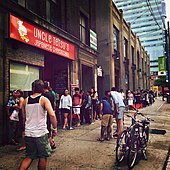Japanese Canadians in the Greater Toronto Area
| Part of a series on |
| Ethnicity in Toronto |
|---|
|
|
|
|
Toronto has a population of Japanese Canadians and also one of Japanese nationals. As of 2010 there are about 20,000 Japanese Canadians in Toronto.[1] Adam McDowell of the National Post stated that Toronto's Japanese community was "never very large compared to, say, the Chinese or Italian communities".[2]
Since the mid-2010s, Toronto has a Little Japan, which was formerly the city's first Chinatown.
History[]
Two silk workers, Kenji Ishikawa and Shigesaburo Ubukata, appeared in the City of Toronto Directory in 1897; they were the first persons of Japanese heritage to appear in this directory.[1]
There were only six Japanese families in Toronto until 1941, when Japanese Canadians were moved from the Pacific Coast as a result of World War II. The population of Japanese Canadian individuals in Toronto increased to 5,000 by 1947.[1] In the 1950s and 1970s Etobicoke, Scarborough, and other suburban areas in Greater Toronto received ethnic Japanese coming from western Canada.[3]
By 2013, there had been an increase in the number of Japanese nationals in Toronto, particularly young people there on working holiday visa wishing to work or live in Canada.[2]
Demographics[]

As of 1999, of the Canadian cities, Toronto had the largest number of pure yonsei. As of the same year, 30.64% of Canadian-born Japanese Canadians are married to one another. This is the highest such percentage of any city in Canada.[4]
In the early 1990s, of the Japanese Canadians in Toronto, about 20–25% were shinijusha, or new immigrants and residents from Japan, who come to Canada so they could become permanent residents.[5]
Institutions[]
The Japanese Canadian Cultural Centre (JCCC) holds Japanese cultural classes, contains a library of Japanese-Canadian and Japanese materials, and includes a gift shop. Bruce Kuwabara and Associates had remodeled the building which the JCCC currently occupies; it moved into it in 1999.[3] It was originally established in 1967.[5]
Other institutions include the Canada Japan Society (日加協会[6]), the Japan Foundation, the Japan Society, and the New Japanese Canadian Association (NJCA).[5]
Media[]
The and the are based in Toronto.[5]
Religion[]
As of 1999 the includes many "Kika nisei", Japanese who had been educated in Japan but had been born in British Columbia, Canada.[4]
Education[]
The Toronto Japanese School, a supplementary Japanese school, serves the city's Japanese national and Japanese Canadian populations.[5]
The Nisshu Gakuin Japanese Language School (日修学院日本語学校) is located in Toronto.[5]
Notable residents[]
- Ken Adachi (journalist)[3]
- George Tanaka (civil rights activist and landscape artist)[3]
See also[]
References[]
- McLellan, Janet (University of Toronto). "Japanese Canadians and Toronto Buddhist Church" (Chapter 2). In: McLellan, Janet. Many Petals of the Lotus: Five Asian Buddhist Communities in Toronto. University of Toronto Press, 1999. ISBN 0802082254, 9780802082251. Start p. 35.
Notes[]
- ^ Jump up to: a b c Ruprecht, Tony. Toronto's Many Faces. Dundurn, November 8, 2010. ISBN 1554888859, 9781554888856. p. 238.
- ^ Jump up to: a b McDowell, Adam. "Exodus from the East: Wave of Japanese youth finding its way to Toronto" (Archive). National Post. March 24, 2013. Retrieved on October 16, 2014.
- ^ Jump up to: a b c d Ruprecht, Tony. Toronto's Many Faces. Dundurn, November 8, 2010. ISBN 1554888859, 9781554888856. p. 239.
- ^ Jump up to: a b McLellan, p. 37.
- ^ Jump up to: a b c d e f McLellan, p. 38.
- ^ gse_multipart8686.jpg
External links[]
- Asian-Canadian culture in Toronto
- Japanese-Canadian culture
- Japanese diaspora by city
- Ethnic groups in Toronto